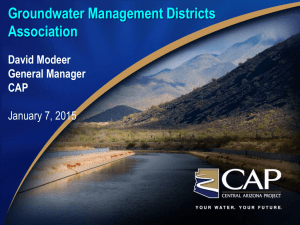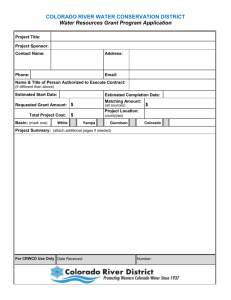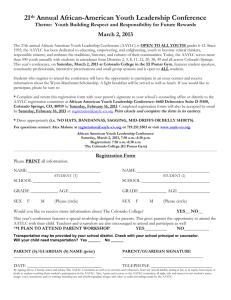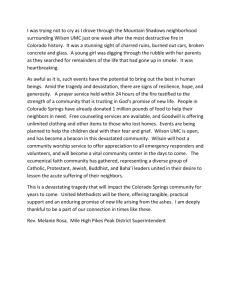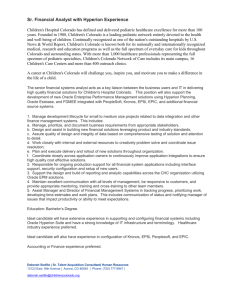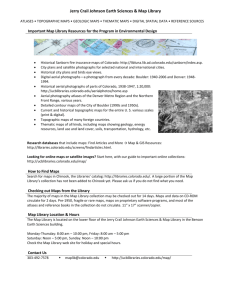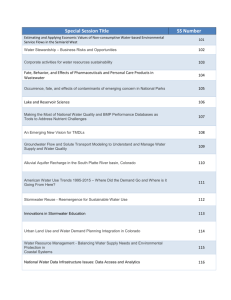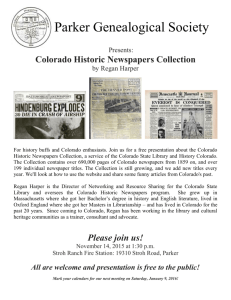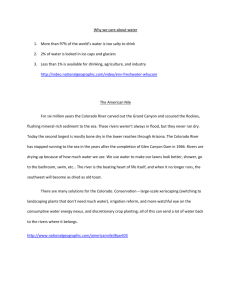Proposed WSRT Framework Study 12-7-15 draft
advertisement
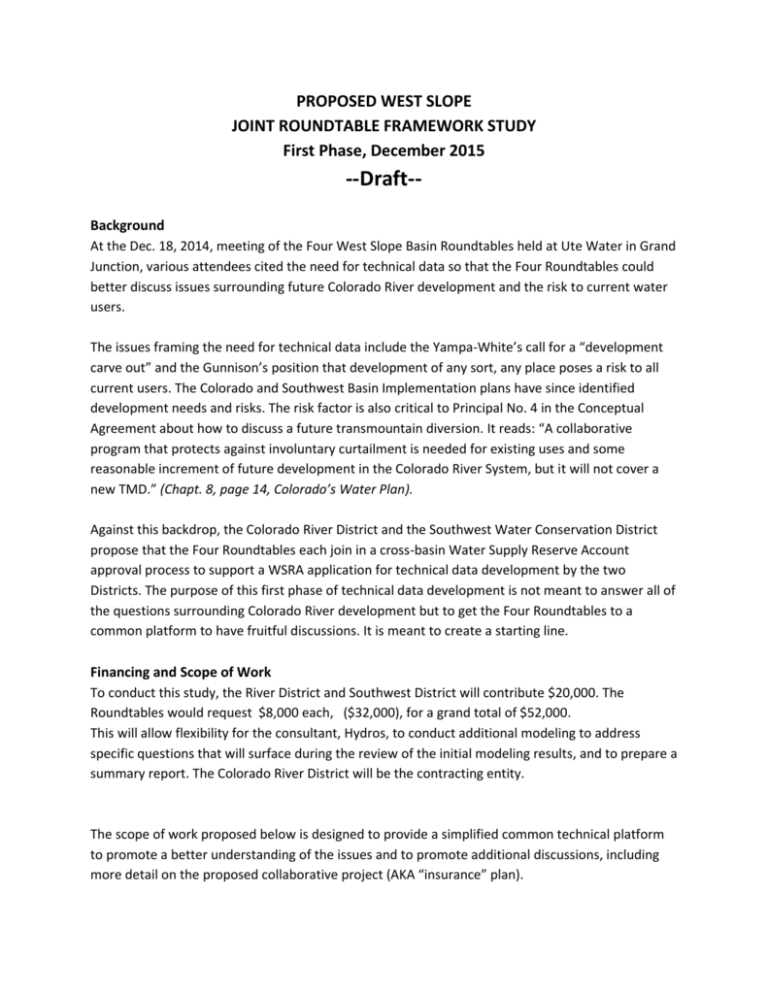
PROPOSED WEST SLOPE JOINT ROUNDTABLE FRAMEWORK STUDY First Phase, December 2015 --Draft-Background At the Dec. 18, 2014, meeting of the Four West Slope Basin Roundtables held at Ute Water in Grand Junction, various attendees cited the need for technical data so that the Four Roundtables could better discuss issues surrounding future Colorado River development and the risk to current water users. The issues framing the need for technical data include the Yampa-White’s call for a “development carve out” and the Gunnison’s position that development of any sort, any place poses a risk to all current users. The Colorado and Southwest Basin Implementation plans have since identified development needs and risks. The risk factor is also critical to Principal No. 4 in the Conceptual Agreement about how to discuss a future transmountain diversion. It reads: “A collaborative program that protects against involuntary curtailment is needed for existing uses and some reasonable increment of future development in the Colorado River System, but it will not cover a new TMD.” (Chapt. 8, page 14, Colorado’s Water Plan). Against this backdrop, the Colorado River District and the Southwest Water Conservation District propose that the Four Roundtables each join in a cross-basin Water Supply Reserve Account approval process to support a WSRA application for technical data development by the two Districts. The purpose of this first phase of technical data development is not meant to answer all of the questions surrounding Colorado River development but to get the Four Roundtables to a common platform to have fruitful discussions. It is meant to create a starting line. Financing and Scope of Work To conduct this study, the River District and Southwest District will contribute $20,000. The Roundtables would request $8,000 each, ($32,000), for a grand total of $52,000. This will allow flexibility for the consultant, Hydros, to conduct additional modeling to address specific questions that will surface during the review of the initial modeling results, and to prepare a summary report. The Colorado River District will be the contracting entity. The scope of work proposed below is designed to provide a simplified common technical platform to promote a better understanding of the issues and to promote additional discussions, including more detail on the proposed collaborative project (AKA “insurance” plan). Initial Goals Include: o What is the likelihood of the elevation of Lake Powell going below 3,525’ under selected water supply and water demand scenarios? o Evaluate how often and by how much water users in the Upper Basin and specifically Colorado would have to reduce demand to maintain Lake Powell elevation above 3,525’. Provide an indication of the “risk” to existing Colorado River water users (West Slope and TMDs). Study Tools and Limitations The model platform for this phase will be CRSS – the Colorado River Simulation System. CRSS is a “big river” model. It operates the major Bureau of Reclamation reservoirs including Lake Powell as contemplated by the 2007 Interim Guidelines and the individual records-of-decision. CRSS models the demands on the Colorado River in and below Lake Mead in significant detail. It is the model used by the 7 states and Reclamation for the Colorado River Basin Report and subsequent modeling work supporting the Basin Report. However, above Lake Powell, the model aggregates demands in the four Upper Division states (and the Upper Basin portion of Arizona) into a small number of nodes. For example, in the Yampa River there is only one demand node. Above Glenwood Springs all of the transmountain diversions are consolidated into one node. However, even with these simplifications, CRSS does a reasonable job of simulating Upper Basin depletions upstream of Lake Powell for the purposes of this study. Assumptions For the initial analysis, the study will consider three different hydrologic options: 1906-2012 disaggregated natural flows (DNF); 1988-2012 (DNF); and, climate change (same base as the Colorado River Basin Study). The study will consider three different demand levels: 2015 (current trends from the Colorado River Basin Study), 2015 plus the amount of additional depletions contemplated by the sub-basin programmatic biological opinions (PBO) or equivalents where no formal PBO exists, and the expansive growth scenario (from the Colorado River Basin Study). 1. 2. Colorado’s current demands/depletions will be set at 2015 levels pursuant to the Basin Study schedule A “current trends” or updated information, if available. The demands/depletions in the other three Upper Division states will be “normalized” to Colorado’s level of depletions based on each state’s apportionment under the 1948 Upper Colorado River Basin Compact Article III apportionments. For example, if Colorado’s depletions are 2,500 KAF, Utah’s depletions would be 2,500 x .23/.5175 or 1,111 KAF. NOTE, under this assumption, Colorado is not relying on, or benefitting from, unused apportionment from another Upper Division state. Colorado’s share of any shortage 3. 4. apportionment will be assumed to be 51.75%. The study may also consider a non“normalized” run, using demand levels from the Colorado River Basin or updated Upper Colorado River Commission depletions modules if they are available. Lakes Powell and Mead will be operated pursuant to the 2007 Interim Guidelines through the study period. The study period will be 2015-2040 (25 years), with a possible later iteration to 2060 to mirror the Colorado River Basin Study. Demands for Lake Mead water will be set by the 2007 Interim Guidelines tiers. Where possible, we will assume that extended operations of the upstream CRSP reservoirs (Aspinall, Navajo and Flaming Gorge) is operational. We may want to consider model runs with and without extended operations. This includes making small adjustments to monthly releases at Powell to maintain an elevation of 3,525’ MSL. The Study Will Not: 1. Operate any individual project not already included in the CRSS model. 2. Operate or evaluate a new transmountain diversion or any other specific “new” project (in the initial iterations; may add later iterations to mirror Colorado River Basin Study export scenarios). 3. Assign Colorado’s shortage “share” to any individual project or basin. 4. Consider or simulate any compact administration. Study Management and Rules of Engagement 1. The study will be managed jointly by the River District and the Southwestern District with assistance of technical representatives from the four West Slope roundtables. The effort needs to be open and transparent. 2. It is anticipated that the study will generate additional questions and the need for further study. Further studies likely will require the development of new modeling tools or the integration of different model platforms such as CDSS and CRSS. Next Steps and Process 1. Eric Kuhn will meet with each of the Four West Slope Roundtables at their first 2016 meetings to explain the proposal and request support. We would like to have approval by all Four West Slope Roundtables and an application to the CWCB by March 1, 2016. The CWCB is aware of this timetable and can get the applications before the board at its March 16-17, 2016 meeting. 2. Roundtable chairs will request volunteers for a technical committee to provide input and oversight to the study, review initial results and communicate study results to the individual Roundtables. 3. The River District will arrange for a seminar on the Colorado River Support System (CRSS) by Hydros. The seminar will be conducted for the benefit of technical team members in early 2016.
